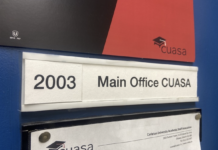Carleton’s Astronomy Nights made a return this year, with the first session hosted on Sept. 23.
Etienne Rollin, the Department of Physics’ laboratory superintendent, hosts Astronomy Nights in the Kessler Observatory, which is located on top of the Herzog Building.
They are free for anyone to attend and occur approximately once a month. Rollin said everyone who is interested should be able to engage in astronomy, regardless of his or her skill level or prior knowledge.
“I organize them to bring the public to our observatory,” he said. “Some people don’t have access to a telescope and we have one here that is not used all the time.”
Rollin said he has been hosting Astronomy Nights for the past seven years. They are capped at 20 people per session and fill extremely quickly, Rollin said, even though sign-ups only occur during the day before a session happens.
Last-minute sign-ups help ensure a cloudless night, Rollin said, but it can also be difficult for people to make last-minute commitments. Because of this, Rollin said he hopes to change the program slightly and is “planning to make things more regular, so trying to set a date beforehand.”
Rollin said he is also looking at creating an entirely new element that includes “projecting on a screen in a classroom.” He said this will make astronomy more accessible for everyone, especially young children, who currently can’t go onto the Herzog Building roof for safety reasons.
“It’s more convenient for kids,” Rollin said. “Hopefully with this new type of observing session I’ll allow kids to come.”
The telescope works by collecting light, which allows greater detail than observation with the naked eye. In addition to stars, Rollin said planets are excellent for viewing because they are very bright.
Saturn and Jupiter are especially easy to view and in good conditions, the rings on the planets and their surrounding moons are visible, Rollin said.
Rollin did not host an Astronomy Night on the night of the total lunar eclipse due to the cloudy conditions. However, he said he hopes people viewed it from home, as the moon was easily visible with the naked eye.
“People are always interested in astronomy. I don’t know anybody who’s not interested in astronomy. It’s just that sometimes they don’t have the tools or the knowledge to understand what’s going on in the sky,” he said.






